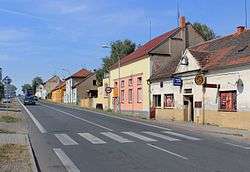Zbůch
Zbůch (German: Zwug) is a municipality and village in Plzeň-North District in the Plzeň Region of the Czech Republic. It has a population of about 2,600.
Zbůch | |
|---|---|
 Main street of Zbůch | |
 Flag  Coat of arms | |
 Zbůch Location in the Czech Republic | |
| Coordinates: 49°40′43″N 13°13′33″E | |
| Country | |
| Region | Plzeň |
| District | Plzeň-North |
| First mentioned | 1253 |
| Area | |
| • Total | 8.57 km2 (3.31 sq mi) |
| Elevation | 338 m (1,109 ft) |
| Population (2020-01-01[1]) | |
| • Total | 2,609 |
| • Density | 300/km2 (790/sq mi) |
| Time zone | UTC+1 (CET) |
| • Summer (DST) | UTC+2 (CEST) |
| Postal code | 330 22 |
| Website | www |
Geography
The municipality has a total area of 8.57 square kilometres (3.31 sq mi), of which, 8.42 km² (5.23 square miles) is land and 0.14 km2 (0.054 sq mi) is water.[2] The municipality lies approximately 14 kilometres (9 mi) south-west of Plzeň and 98 km (61 mi) south-west of Prague. The terrain is flat to slightly undulating.[3]
History
Early history
Zbůch was previously known as the Zbuoch, Zwug, and Zwuch. The earliest written mention of Zbůch comes from 1253, when it was cited as a property of the monastery in Chotěšov Premonstratensian. However, the settlement is thought to have its roots in prehistoric times, as evidenced by numerous archeological finds in the area dating from the Bronze Age. During the Middle Ages the area was established farmyard that was owned by a number of secular feudal lords, such as the Great Zbůch or Votíka of Chotěšovic during the 15th century. Shortly after the 17th century, tax records state that only five farmers lived in the village. The last feudal lords, whose family farmed Zbůch until the first land reform, built a large noble manor on the northern outskirts of the village. The site is still partially preserved. Records from the 19th century suggest the village consisted of 28 houses. In 1861 a railway line from Plzeň to Brod was built near the village, however, a railway station for the village was not opened until 1906.[3]
20th century
By the end of the 19th century, Zbůch was a small agricultural village connected to the nearby parish of Úhercům. The village consisted of a small village square lined with farmhouses, which was dominated by the chapel. In the first 20 years of the 20th century, the population increased from the original few dozen to about two thousand by 1921. This population boom was due to the development of the coal mines on the edge of the village. In January 1919, the first general school was established in Zbůch. By 1932, after many delays, a fully functional school building was built in the village. By the mid-1920s, the village had built a town hall with a memorial statue of president Tomáš Garrigue Masaryk out front.[3]
In October 1938, following the Munich Agreement, Zbůch was ceded to the Nazi Germany, along with other lands in the Sudetenland region. Although there were many Czech/non-Germans living in the village who migrated there to work the coal mines, the village was considered German and subject to the Munich Agreement. Many Czech miners were forced into early retirement to accommodate large numbers of French and later Russian prisoners of war which were interned here.[3] At the beginning of 1945 U.S. tanks liberated the area from Nazi occupation on their way to meet with Russian allies in Torgau.[4] After the war the region was ceded to the new Czechoslovakia. Most ethnic Germans were forcibly removed and resettled within the newly established borders of Germany.
In the period after February 1948, the communist government took state ownership of the mine and collectivized the local peasant labor force. The former camp was gradually transformed into a hostel. Although part of the area works was acquired by private individuals. The pub near the railway station was built to house a cultural hall, which became the largest facility of its kind in the Plzeň-North District. Since 1990 the private companies have transformed the mining facilities for the production of precast concrete, interlocking tiles, and several other products. Several apartment buildings were built near the concrete plant and near the soccer field in the center of the village. In recent times the northern and eastern side of the village square was demolished and planning for the site includes a small mall.[3]
Village of Červený Újezd
The nearby small village of Červený Újezd is now part of the municipality of Zbůch. The earliest written mention of this village is in the property listing of the Kladruby Benedictine monastery dating from 1115. Later the village became the property of the monastery in the neighboring Chotěšov. In the late 18th century, the village consisted of 16 residential listings. In October 1938 the village was annexed by the Nazi Germany along with Zbůch. After the war, the local ethnic Germans were forcibly resettled within the new German boundaries and replaced by settlers from the Pilsen region as well as the Czech Republic's interior. The village has retained its historic village square, with a chapel and several valuable estates. Address No. 2 is a unique residential timbered house dating from 1773. At the beginning of the 1950s, a military airfield was built in the woods above the village.[3]
Mining activities
The Western Bohemia Mining stock club was built between 1906 and 1908, on the eastern outskirts of the village, between Zbůch and the nearby village of Červený Újezd. The site has two deep mining pits (800 and 720 m) of exceptional quality coal, used in the manufacturing of gas and coke, and also in the chemical industry. After 1918 the original name was changed to Masaryk Jubilee mine in honor of Tomáš Garrigue Masaryk, founder and first President of Czechoslovakia. This name lasted until the 2nd half of the 20th century, with an exception during World War II when the name was temporarily changed to the Adolf Hitler mine. The mining of coal significantly increased the size of the village during the early 20th century. At one time the mine was among the largest buildings of its kind in the Plzeň Region. After 1948, Masaryk Jubilee was renamed the Jubilee Mine Pit Defenders of Peace.[3]
Mining operations ceased in 1977. In the 1950s, a mining school built in Zbůch. It was closed in 1966 and later became a Social Care Institute for physically and mentally handicapped kids. Most of the mine buildings were demolished shortly after the operations ended. Remnants of the once grand mine still fascinate visitors. The site is a standing reminder of the construction of industrial buildings in the first decades of the 20th century. The dominant feature is the extraction belt reaching an impressive height of 100 m. The area around the former Masaryk Jubilee mine has become an industrial zone.
A smaller mine was also located in the village of Zbůch. Operations started in 1889 and ended in 1965. After closing down operations the site received repair of railway rolling stock. After 1990 the buildings previously belonging to the shaft were taken over by a company dedicated to the marketing of kitchen spices. The mine is located near a former row of tenement houses.
Transport
The municipality is undergoing development of a major transportation artery. The artery consists of a highway from Plzeň to Domažlice, and railroad tracks, also from Plzeň to Domažlice. Approximately 1 km north of Zbůch lies the D5 motorway which runs from Prague, through Plzeň, to Rozvadov on the border of Austria.[3]
References
- "Population of Municipalities – 1 January 2020". Czech Statistical Office. 2020-04-30.
- Czech Statistical Office: Municipalities of Plzeň-North District
- "Historie obce" (in Czech). Obec Zbůch. Retrieved 2020-07-28.
- The War is Over - American and Russian troops meet at the Elbe, A People At War, U.S. National Archives and Records Administration
| Wikimedia Commons has media related to Zbůch. |